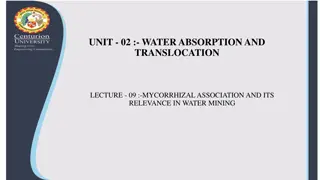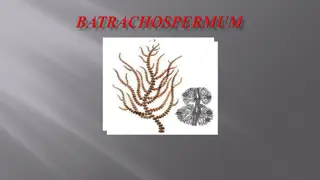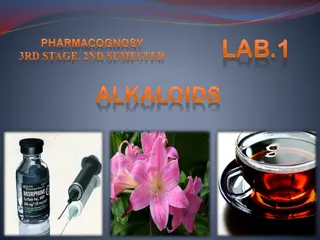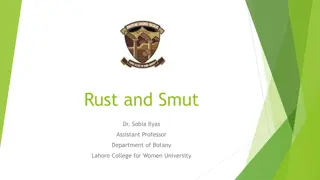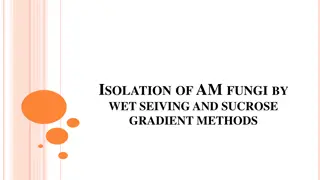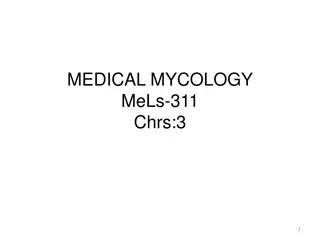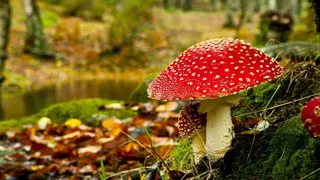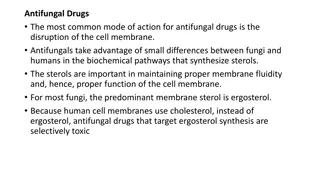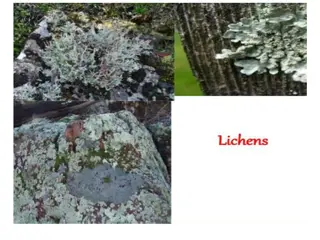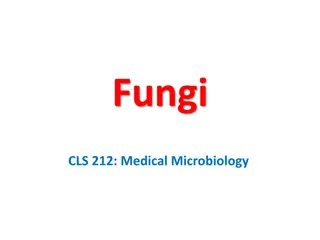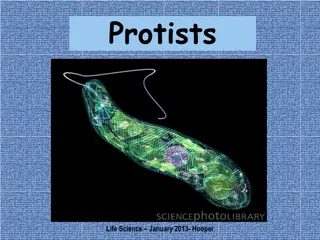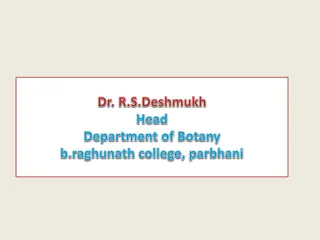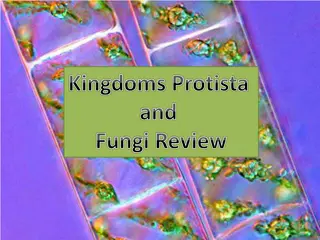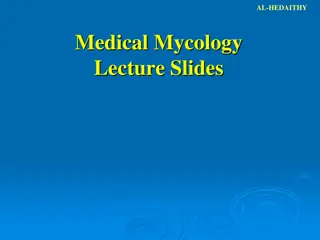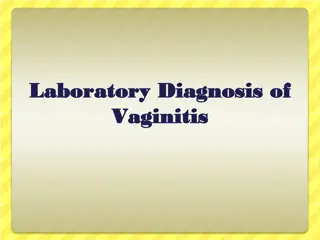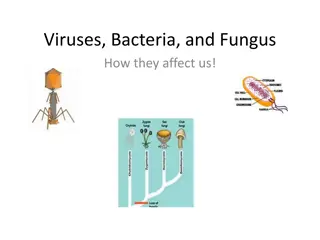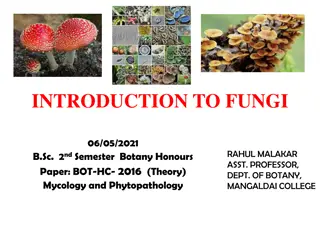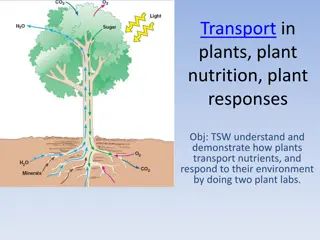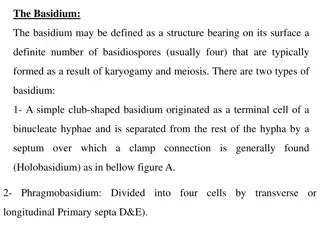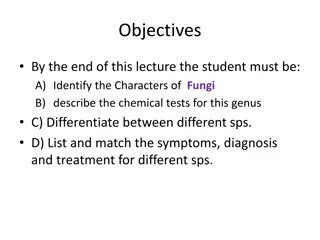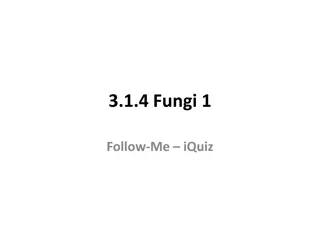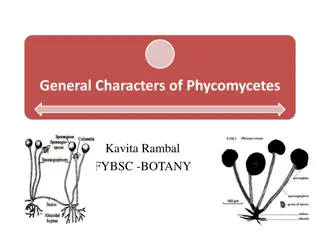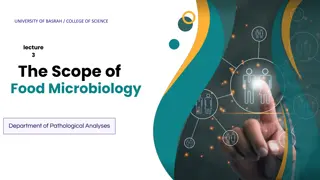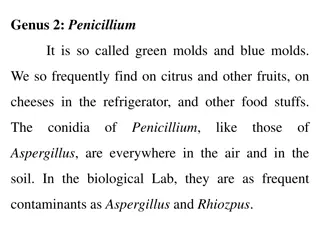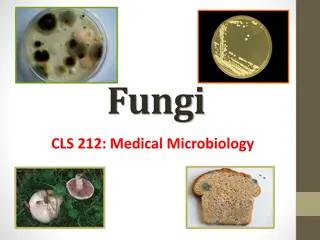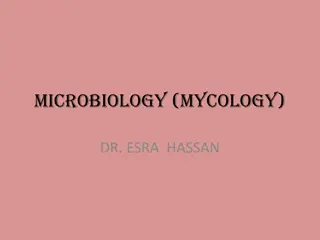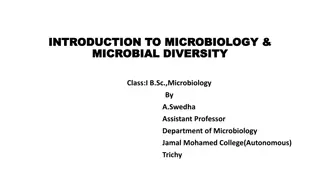Mycorrhizal Association and Its Importance in Water Mining
Mycorrhizal association plays a crucial role in facilitating nutrient and water absorption for plants through a symbiotic relationship with fungi. This relationship enhances the plant's ability to acquire minerals from the soil while providing essential compounds to the fungi. The mycorrhizal associ
3 views • 6 slides
Understanding Batrachospermum: A Freshwater Red Alga
Batrachospermum, a red alga commonly found in freshwater habitats like streams, ponds, and lakes, is characterized by its beautiful, gelatinous thallus structure. The plant body grows up to 15-20 cm and exhibits varying colors based on light exposure. Its thallus is differentiated into prostrate and
3 views • 17 slides
Understanding Alkaloids: Sources, Names, and Classification
Alkaloids, organic nitrogenous compounds of plant origin, are physiologically active and can contain elements like carbon, hydrogen, nitrogen, oxygen, sulfur, and more. They are found in various plant families such as Leguminosae, Papaveraceae, and Solanaceae. Alkaloids can be sourced from plants, a
3 views • 21 slides
Understanding Rust and Smut Fungi in Basidiomycotina
Basidiomycotina is a diverse group of fungi encompassing classes like Teliomycetes and Hymenomycetes. Rust and smut fungi belong to the class Teliomycetes, characterized by dikaryotic resting spores and unique modes of reproduction. Within the Teliomycetes, the order Uredinales, known as rust fungi,
0 views • 21 slides
Understanding Fungal and Protist Diseases: Impacts and Prevention
Fungi and protists play significant roles as pathogens, causing diseases in both humans and plants. Fungal diseases like athletes foot and protist diseases like malaria can have serious impacts on health. Control measures such as understanding symptoms, spread mechanisms, and prevention strategies a
0 views • 10 slides
Isolation of AM Fungi by Wet Sieving and Sucrose Gradient Methods
Wet sieving is a popular technique to isolate different sizes of spores from soil samples. Developed by Gerdemann and Nicolson in 1963, this method involves passing an aqueous suspension through different sieves to collect spores of varying sizes. The process includes agitating the soil-water mixtur
0 views • 14 slides
Industrial Production of Citric Acid: Fermentation Processes and Applications
Citric acid is industrially produced through microbial fermentation processes. It is widely used in various industries such as food, pharmaceuticals, and beverage production. Different methods like surface culture fermentation are employed for citric acid manufacture, with fungi like Aspergillus nig
4 views • 18 slides
An Overview of Medical Mycology: Fungi and Their Characteristics
Medical mycology, focusing on fungi that infect humans, explores the study of fungi, their morphology, classification, and diseases. Fungi, non-photosynthetic organisms, lack chlorophyll and depend on external organic sources for nutrients. With an eukaryotic nature, fungi exhibit less differentiati
0 views • 68 slides
Understanding Fungi Diversity and Infections in Microbiology
Explore the world of fungi and fungal infections in this foundation block of microbiology. Learn about medically important yeasts, mold fungi, major fungal diseases, antifungal agents, and infection acquisition methods. Dive into hypersensitivity reactions, mycotoxicoses, and various types of fungal
1 views • 19 slides
Understanding Mycorrhiza: Types, Importance, and Classification
Mycorrhiza is a symbiotic association between fungi and plant roots crucial for plant survival. Around 95% of plant species form mycorrhizal relationships, with mycorrhizae existing since the earliest land plants. Classification includes Ectomycorrhiza and Endomycorrhiza based on tropic levels. Ecto
0 views • 21 slides
Understanding Antifungal Drugs: Modes of Action and Applications
Antifungal drugs target ergosterol biosynthesis in fungi, disrupting cell membrane integrity. Imidazoles like miconazole and ketoconazole are commonly used for skin infections, while triazoles such as fluconazole treat systemic yeast infections. Allylamines inhibit ergosterol synthesis, with terbina
0 views • 13 slides
Understanding Chytridiomycota: The Flagellated Fungi
Chytridiomycota is a phylum of fungi distinguished by having motile spores with a single posterior flagellum. They are primarily aquatic, parasitic on algae and animals, and play a role in plant diseases. Their unique characteristics include alternation of generation and somatic phase with rhizoids.
8 views • 11 slides
Reproduction in Organisms: Overview and Types
Understanding the concept of reproduction in organisms, this content delves into the different modes of reproduction such as asexual and sexual, with examples and illustrations. It covers the life spans of various organisms and details various methods of asexual reproduction like fission, budding, s
0 views • 23 slides
Understanding Lichens: A Symbiotic Organism in Nature
Lichens, a unique symbiotic organism combining a fungus and alga or cyanobacterium, are widely distributed and diverse in nature. Comprising of 186 plant species from 148 genera and 63 families, lichens are versatile in their adaptation to different habitats and substrates. This article delves into
0 views • 21 slides
General Characteristics of Phycomycetes in Fungi Classes
Fungi are classified into four classes based on hyphae, spores, and reproduction methods. Phycomycetes, as an algal-like fungi class, showcase varied forms with reproduction mainly through sexual or asexual means. The thallus structure varies from one-celled to well-branched mycelium, and reproducti
0 views • 22 slides
Understanding the Fascinating World of Fungi: Mycology Insights
Explore the realm of fungi through the lens of mycology, delving into their diverse characteristics, including their eukaryotic nature, heterotrophic lifestyle, and impact on various ecosystems. Discover how fungi play crucial roles as saprophytic, symbiotic, or parasitic organisms, influencing food
0 views • 26 slides
Understanding Ecosystem Changes Caused by Living Organisms
Explore the effects of changes in ecosystems caused by living organisms, including humans, such as the overpopulation of grazers or the introduction of invasive species like kudzu. Learn how these factors impact native plants, water supply, weather patterns, and the balance of organisms within ecosy
0 views • 97 slides
Microorganisms: A Treasure Trove of Medicinal Compounds
Microorganisms like bacteria and fungi have been crucial in the discovery of drugs, especially antibiotics. The screening of microorganisms has led to the identification of various bioactive substances with therapeutic applications spanning from antibacterial agents to anti-cancer drugs. The success
1 views • 19 slides
Exploring the World of Protists: A Kingdom of Diversity
Protists are eukaryotes that cannot be classified as plants, animals, or fungi. They thrive in moist environments and showcase a remarkable diversity within the Kingdom Protista. From animal-like protozoa to plant-like autotrophs and fungus-like heterotrophs, this kingdom contains a wide array of un
0 views • 18 slides
Introduction to Lichens: General Overview, Classification, and Economic Importance
Lichens are symbiotic organisms composed of fungi and algae, with the algal component synthesizing food while the fungal component provides structure. They have unique characteristics and are classified based on their fungal partner, thallus forms, and habitat. Ascolichens and Basidiolichens are two
0 views • 24 slides
Exploring Kingdoms Protista and Fungi: Characteristics and Structures
Dive into the world of Protista and Fungi through this interactive review. Discover the unique characteristics of protists, identify different types of protists, and learn about essential structures in protists such as contractile vacuoles. Explore the significance of compounds like fucoxanthin in b
0 views • 27 slides
Comprehensive Overview of Medical Mycology and Fungal Structures
Explore the field of medical mycology through lecture slides by AL-HEDAITHY covering various topics such as basic mycology, superficial mycoses, primary systemic mycoses, fungal structures, and reproduction in fungi. Dive into details about different fungal infections, their characteristics, forms o
0 views • 94 slides
Understanding Vaginitis and Vulvovaginitis: Diagnosis and Management
Vaginitis and vulvovaginitis are common inflammatory conditions affecting the vagina and vulva, often caused by disruptions in normal flora or pH levels. Key pathogens include bacteria like Gardnerella vaginalis, fungi such as Candida species, and parasites like Trichomonas vaginalis. Bacterial vagi
0 views • 42 slides
Understanding How Viruses, Bacteria, and Fungi Impact Human Health
Explore the intricate world of viruses, bacteria, and fungi and how they interact with living organisms. Learn about the structure and functions of viruses, the role of bacteria in diseases, and the implications of fungi on human health. Discover the different ways these microorganisms affect us and
0 views • 37 slides
General Characteristics of Fungi and Mycology Overview
Fungi, diverse eukaryotic organisms, exhibit various characteristics such as heterotrophic nature, distinct cell wall composition, and different modes of reproduction. Mycology, the study of fungi, delves into their classification and functions. Fungal cells may be unicellular or filamentous, with m
0 views • 15 slides
Understanding Plant Transport, Nutrition, and Responses
The process of how plants transport nutrients and respond to their environment is demonstrated through labs focusing on protein transport, water absorption by roots, and control of transpiration using mechanisms like diffusion, osmosis, and symbiotic relationships with fungi. Various components in p
0 views • 28 slides
Understanding Basidium: Structure and Classification of Basidiomycetes
The basidium is a key structure in fungi bearing basidiospores formed through karyogamy and meiosis. Basidiomycetes are classified into sub classes based on basidium types such as Heterobasidiomycetidae and Homobasidiomycetidae. Uredinales and Ustilaginales are orders of basidiomycetes involving rus
0 views • 6 slides
Overview of Marine Fungi and Their Habitats
Marine fungi are diverse species that inhabit marine environments, with some being obligate marine fungi while others can adapt to various habitats. They play essential roles in marine ecosystems by decomposing organic matter and interacting with other organisms. Factors affecting their distribution
2 views • 13 slides
Understanding Fungi: Characteristics and Types in Medical Mycology
Explore the world of fungi in medical mycology, including their characteristics, chemical tests, species differentiation, symptoms, diagnosis, and treatment. Learn about dermatophytosis, dermatomycosis, actinomyces, and the differences between fungi and bacteria. Discover the various types of fungi,
0 views • 68 slides
Understanding Yeasts and Rhizopus in the Fungi Kingdom
Explore the characteristics of yeasts and Rhizopus within the Fungi kingdom through a series of quiz questions. Learn about their habitats, modes of reproduction, and unique features that distinguish them as fungi. Test your knowledge and delve into the fascinating world of these microorganisms.
0 views • 50 slides
Understanding Antibiotics and Their Effects on Germs
Explore the world of antibiotics and their impact on bacteria, fungi, viruses, and mild bacterial infections. Delve into the chemistry of antibiotics, their mechanisms, and how they combat various germs. Learn about the treatments involving antibodies and specific conditions like Helicobacter pylori
0 views • 18 slides
General Characteristics of Phycomycetes: An Overview
Phycomycetes constitute an important class of parasitic or saprophytic fungi, exhibiting characteristics ranging from undifferentiated masses to well-developed mycelium. They reproduce sexually and asexually, utilizing spores, conidia, and chlamydospores. The thallus structure varies, with some havi
0 views • 22 slides
Insights into Airborne Microorganisms and Fungi: Implications for Food Safety
Airborne microorganisms and fungi play crucial roles in food microbiology, with various species surviving in the atmosphere despite hostile conditions. Bacteria like Bacillus and Streptomyces disperse through air turbulence, while fungi such as Penicillium and Aspergillus produce spores resistant to
0 views • 9 slides
Fascinating Insights into Lichens: Algae, Fungi, and Ecological Succession
In the world of lichens, a unique symbiotic relationship between algae and fungi thrives, showcasing the wonders of mutualism. Through photosynthesis, algae produce glucose and oxygen, while fungi provide stability and protection on rocks. This partnership plays a crucial role in primary succession,
0 views • 4 slides
Insights into Penicillium and Gymnoascaceae Fungi
Penicillium fungi, known as green molds and blue molds, are commonly found on citrus fruits, cheeses, and other food items. Various Penicillium species can cause fruit decay and are used in antibiotic production. Gymnoascaceae fungi include dermatophytes and systemic pathogens for humans. Nannizzia
0 views • 6 slides
Understanding Biogeochemical Cycles and Their Impact on Earth's Ecosystems
Biogeochemical cycles involve the cycling of essential nutrients like water, carbon, oxygen, nitrogen, phosphorus, and sulfur through abiotic components like water, air, soil, and rock to biotic components like plants, animals, fungi, and bacteria. Humans play a significant role in these cycles, imp
0 views • 24 slides
Understanding Infectious Diseases and Prevention Strategies
Infectious diseases are caused by pathogens like bacteria, viruses, parasites, or fungi invading the body. These diseases can spread from person to person and sometimes from animals to humans. Common characteristics include potential severe outcomes, transmission modes, and the role of pathogens. Th
0 views • 27 slides
Understanding the Fascinating World of Fungi in Medical Microbiology
Fungi are eukaryotic organisms with diverse characteristics and roles in nature. They are essential for the ecosystem, being heterotrophic and distinct from plants. In medical microbiology, fungi play crucial roles, such as in the production of antibiotics and foods like cheese. The classification,
0 views • 34 slides
Understanding Fungi: A Brief Overview of Mycology in Microbiology by Dr. Esra Hassan
Fungi, classified as living eukaryotic microorganisms, exhibit diverse structural forms such as yeasts and molds in mycology. This field explores the characteristics, pathogenicity, and importance of fungi, particularly Candida in oral mycology. Discover the fundamental concepts of morphology, hypha
0 views • 32 slides
Exploring Microbial Diversity: Fungi in Microbiology
Microbes are vital single-celled organisms that exist everywhere, some beneficial while others harmful. Fungi, a crucial group of microbes, can be unicellular or multicellular, with diverse roles in nature and human activities. This article delves into the characteristics and classification of fungi
0 views • 15 slides
